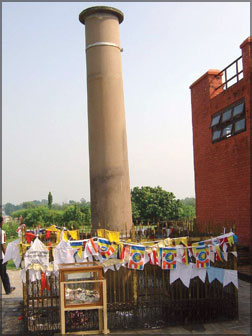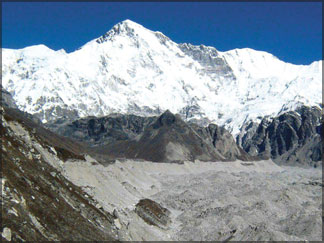
The Great Quest
Benoy BEHL
IT was the beginning of the first millennium B.C. There were many
principalities in the northern plains of India. Some of them were Jana-Samghas,
ruled by elected councils. In others, the concept of hereditary leaders
was evolving.
|

Mahabodhi Temple, Bodh Gaya |
|

Asoka Pillar, Lumbini |
It was a time when great philosophic concepts, which were to last
forever, were being crystallised. By the 8th century B.C., the early
Upanishads were composed, out of the continuing traditions of the land.
The main illusion, which keeps us bound to the material world,
forever seeking its fruits and benefits, is the ego. We imagine
ourselves to be distinct and separate entities and forever chase our
ambitions and desires.
The spell has to be broken to attain the peace of the truth.
In this period, numerous thinkers gave up the attractions of the
ephemeral world to pursue the search for the truth. They left behind
their material possessions and the emotional bonds with their families
to wander homeless.
Two of the greatest of these renouncers were Gautama Siddhartha and
Mahavira. Gautama is known as the 4th or the 7th Buddha, or ‘Enlightened
One’, and Mahavira is known as the 24th ‘Tirthankara’, or ‘Victor’ over
the fear of death. Their followers form two of the great religions of
the world: Buddhism and Jainism.
Gautama Siddhartha, the son of Suddodhana, the ruler of the Sakya
clan, was one of humanity’s wisest teachers. He was born circa 563 B.C.
Suddodhana ruled from the town of Kapilavastu, in present-day Uttar
Pradesh in India.
The site of Kapilavastu has been excavated near the villages of
Piprahwa and Ganweria.
It is believed that before Gautama was born his mother, Queen Maya,
had a dream. In her sleep, she saw a white elephant entering her womb.
Asita, the court astrologer, was told about it. He said, “Queen Maya,
you will have a son. He will be destined for greatness, in whichever
path he chooses, whether as a great king or as a renouncer and saviour
of mankind.” Thus the arrival of a great being was heralded.
Just before she was to give birth, Maya set out for her father’s
town, Devadaha. On the way she halted in a grove at Lumbini, which is in
present-day Nepal. Here, as she reached up to take support of a branch
of a sal tree, a son was born from under her raised arm.
|

The Himalaya mountains of India |
The deities Brahma and Vishnu are believed to have been present to
receive the child. When he was born, the child took seven steps and
said, “I am one who will tread the path taken by others before me.”
Asoka, the great Mauryan emperor of the 3rd century B.C., erected a
pillar at Lumbini to commemorate this sacred site. After Gautama’s
birth, Maya bathed in a pond and Gautama is said to have been given an
abhisheka, or ritual shower, by celestial creatures.
Gautama led a princely life and was kept away from all the pains and
miseries of the world. His parents were afraid of the possibility that
he may renounce the world to become an ascetic. However, Gautama had a
thoughtful nature and an inclination towards meditation.
At the age of 29, his life took a different turn. On separate
occasions, when he was driven outside the palace by his charioteer, he
saw four sights, which set him thinking. He saw a very old and feeble
man, an extremely sick man and a dead man being taken for cremation.
As he was sheltered from the realities of life, these sights stunned
him. He realised that all pleasures were transitory. On a fourth
occasion, he saw an ascetic, whose face was serene. Gautama decided to
renounce the fleeting pleasures of the world.
In the stillness of the night, Gautama bade a silent farewell to his
sleeping wife and son. He left the palace quietly on his horse Kanthaka,
accompanied by his charioteer Chandaka. It is said that celestial beings
cushioned his horse’s hooves as he rode so that the sound would not
awaken the sleeping palace.
For six years, Gautama wandered all over Bihar in his quest for true
knowledge. He looked for teachers who may be able to show him the path
of release from samsara, the endless cycle of life and death in the
illusory world. None was able to satisfy him. He subjected himself to
the severest austerities in the belief that this would elevate the mind.
He denied himself food and water until he was reduced to a skeleton.
However, the truth remained beyond his grasp.
Seeing the futility of self-mortification, Gautama decided to take
nourishment again. This would sustain his body and give him the clarity
of mind he desired. He accepted a bowl of sweet rice-milk offered to him
by a village girl called Sujata. At the village of Uruvela, Gautama sat
down to meditate under a pipal tree. For days he sat in meditation,
determined to seek the truth.
Mara and his armies, the personifications of doubts, confusions and
temptations, assailed him from time to time. However, he was unshaken in
his meditation and his will to escape the desires and pains of the
material world. It was a full moon night. Gautama sat under the tree and
continued his quest. Finally, his mind dispelled all the darkness of
confusion. He fully realised the truth of the cause of suffering and the
path to happiness.
After six years of struggle, Gautama attained his goal: he had become
a Buddha, one who had gained Bodhi, the knowledge of the truth. One
man’s glorious journey in search of enlightenment had concluded
successfully. In this was the beginning of a great journey for mankind.
Gautama Buddha meditated at the place of his enlightenment and arose
after 49 days. He had resolved to preach what he had realised.
Thereafter, the site of the Buddha’s enlightenment became one of the
most sacred spots. It is today known as Bodh Gaya. A rock edict records
Asoka’s visit to Bodh Gaya in the 3rd century B.C. Here, he erected a
shrine to commemorate the sacred spot. Under the Bodhi tree, there is
still a stone seat, the Vajrasana, which has an inscription of that
period. The geese and palmette motif on the seat are also typical of
Asoka’s time. The site also flourished greatly under the Pala and Sena
rulers between the 8th and 12th centuries. Many fine sculptures of this
period are preserved in the nearby archaeological museum.
At Sarnath, near Varanasi, the Buddha delivered his first sermon to
his five former companions. This event is known as the Dharmachakra
Pravartin, or the setting into motion of the Wheel of Law.
Hearing the Buddha’s enlightened words, the five ascetics were at
once converted and formed the nucleus of the Buddhist Sangha, or Order.
|

Dhamek Stupa, Sarnath |
The Dhamek Stupa is said to stand at the exact place where the Buddha
preached to the five ascetics in the deer park. The walls of this stupa
are decorated with many beautiful carvings. The date of the present
stupa is not certain. However, archaeologists have discovered another,
smaller stupa within it. This is believed to have been made by Asoka in
the 3rd century B.C.
Asoka built many great stupas to honour the Buddha. Each of these was
called a Dharmarajika stupa, and these contained the holy relics of the
Buddha. One of these is at Sarnath.
Sculptures belonging to different periods have also been found at the
site, which has continued to be in worship till today. Some of the most
beautiful Buddha figures here are of the Gupta period, around the 5th
century A.D.
There is a peaceful expression and an inward look that marks the art
of this period. Here we see the Buddha in the Dharmachakra Pravartin
mudra, setting into motion the Wheel of the Law or Dharma. Asoka also
erected many impressive pillars to commemorate events of the Buddha’s
life.
The Asoka pillar at Sarnath, with its famous capital of four lions,
was erected at the place where the Buddha established his first Sangha,
the Buddhist congregation. The lion capital of this pillar is the
national emblem of the Republic of India.
The Buddha wandered ceaselessly from place to place in present-day
Bihar and Uttar Pradesh. He taught dharma to all without any
distinction. He and his disciples lived on alms. This wandering life
ceased only in the monsoons when the rain came down hard.
The Buddha frequently visited Rajgir, the capital of the kingdom of
Magadha.
He spent many monsoons preaching there. After he passed away, the
First Buddhist Council was convened at this site. Modern-day Rajgir
preserves the remains of this ancient past. In these, historians have
tried to identify places associated with the events of Buddhist history.
The Buddha preached in the easily understood local dialect of the
people. He spoke of universal equality, charity and logical reasoning.
Large numbers flocked to his sermons and became his followers.
At the age of 80, Gautama Buddha headed to Kushinagar in present-day
Uttar Pradesh. There he told his close disciple Ananda that his end had
come.
Ananda was miserable and cried bitterly. The Buddha asked him not to
grieve the loss of his master’s ephemeral self. He said, “Dharma is your
refuge.”
The Buddha addressed the Sangha one final time and said at the end:
“All that comes to existence must fade away. Let your striving alone
never come to an end!” The year was 483 B.C. and these were the Buddha’s
last words.
Following the Buddha’s Mahapariniravana, his relics were distributed
among seven groups of his followers, who enshrined them in stupas. The
Pali chronicles tell that Asoka opened these original stupas and
redistributed the relics in other stupas across his empire.
Archaeological excavations have shown that the core of the stupas at
Sanchi and Amaravati dates back to Asoka’s period. However, building
activity continued at these sites. What is visible today does not belong
to the Mauryan period.
Since earliest historical times, the kings and the people of this
land presented a unique and fascinating culture. There were no portraits
of rulers made in ancient India. Asoka does not even mention his own
name in most of his edicts. He is just referred to as Devanampiya
Piyadasi, “beloved of the divine” and “one whose vision is filled with
adoration”. Besides his visits to many Buddhist pilgrimage sites, he
also excavated great caves out of the hills at Barabar in Bihar. These
were made for the ascetic sect of the Ajivikas.
Asoka’s inscriptions of the 3rd century B.C. are a remarkable record
of a compassionate and cosmopolitan vision: a vision that has not been
surpassed by any ruler till today. He says, “His Sacred Majesty does
reverence to men of all sects. A man must not do reverence only to his
own sect while disparaging the sects of others.”
Frontline |



